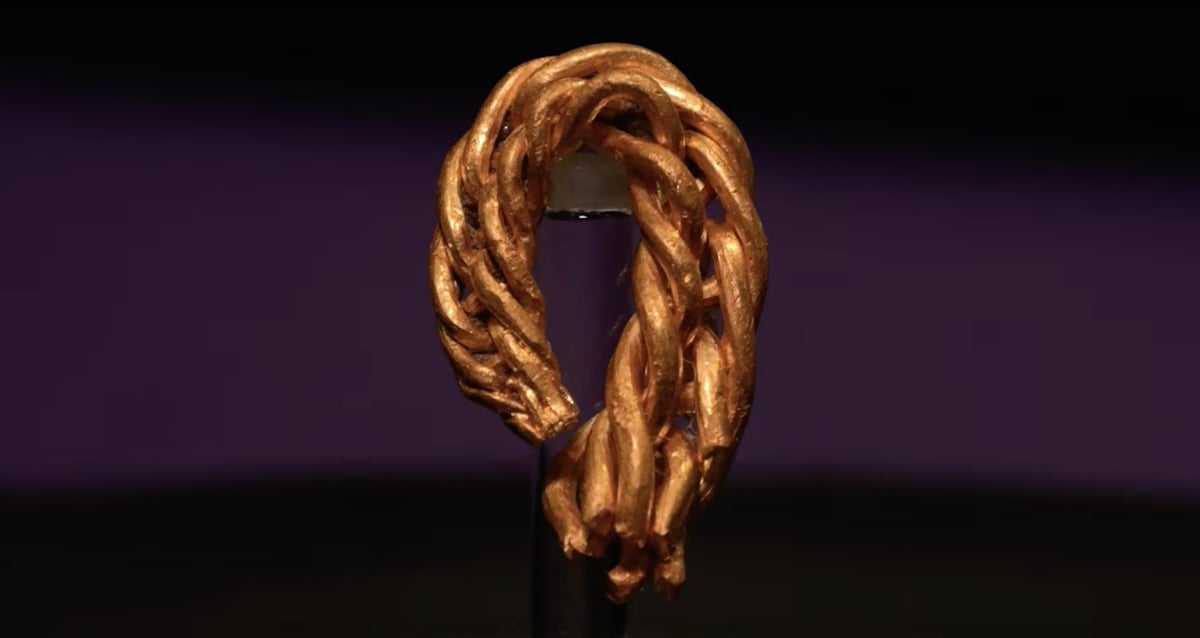Unearthed After a Millennium: The Mysterious Viking Gold Armband Discovered on Isle of Man Could Rewrite History
Fifty years of swinging a metal detector and what do you get? Not another rusty spoon or some ancient bottle cap — no, you hit pay dirt with a Viking armband made of eight gold rods braided like some ancient bling straight out of a history book. Ronald Clucas, who probably thought his greatest find was behind him, somehow stumbles upon a 1,000-year-old piece of Viking swagger right on the Isle of Man. This isn’t just jewelry; it’s a golden ticket into the economy and everyday hustle of Vikings, who used flashy arm-rings as both cash and status symbols. Imagine that – your jewelry pulled double duty as a wallet! And the story doesn’t end there. This piece was literally cut and traded like a medieval credit card, before eventually getting buried — maybe lost, maybe a sacred offering. It’s discoveries like this that make you wonder how many stories are just waiting to be dug up… or maybe how many Vikings just misplaced their valuables after a night of mead-fueled revelry. Either way, Clucas’ golden anniversary to metal detecting just got a heck of a lot shinier. LEARN MORE
Ronald Clucas has been using his metal detector for 50 years, and he just made his greatest discovery yet: a Viking armband made of eight gold rods braided together into an intricate pattern.

Manx National HeritageThe recently discovered Viking armband found on the Isle of Man.
Ronald Clucas has been metal detecting for 50 years, and upon his golden anniversary in the hobby, he just unearthed an astonishing artifact made of gold.
During one of his routine outings in the spring of 2025, Clucas came across a rare fragment of a gold Viking armband dating back to between 1000 and 1100 C.E.
The Discovery Of A 1,000-Year-Old Viking Armband Made Of Gold

Manx National HeritageRonald Clucas (left) has been metal detecting for 50 years.
The armband was creating by plaiting eight gold rods together, a specialized technique executed by a highly skilled smith. The fragment that Clucas found was folded in two, measuring 1.4 inches long, meaning it would have been around three inches long originally. It weighed in at just under one ounce, which is fairly hefty considering its size.
Clucas said the discovery was “quite a big shock,” in a statement to Manx National Heritage.
“I couldn’t really believe it at first!” Clucas said. “Gold generally gives a very low signal on the detector, so you can’t really predict what is going to be uncovered. I’ve been detecting for many years now and found some wonderful things, but to find a piece of gold from the Viking Age, that’s really something else.”
This discovery puts a spotlight on the Isle of Man’s Viking history, illustrating how the society’s multifaceted economy functioned. As the National Heritage explained, the Isle of Man, in the Viking Age, saw the use of both coins and bullion (silver and/or gold) as a form of currency for trade. As such, jewelry such as this armband served multiple purposes.
“Jewelry items such as this had several functions in the Viking Age both as prized personal possessions and visible displays of wealth,” said Allison Fox, Curator for Archaeology at the Manx National Heritage. “They were easily portable and were also used to cover costs in financial transactions.”
Viking gold is also substantially rarer than silver from the same period.
“This arm-ring has been cut twice, indicating it has possibly been used for at least two separate transactions,” Fox said. “One cut removed the terminal end of the arm-ring, the other one cut the original complete arm-ring almost in half.”
The Armband’s Use In Multiple Transactions Before It Was Ceremonially Buried

Manx National HeritageMade of eight gold rods braided together into an intricate pattern, this piece was undoubtedly the work of a master goldsmith.
Based on Fox’s assessment, it seems that pieces of the armband had indeed been removed during transactions. The terminal that Fox mentioned would have been an end piece or cap of sorts, a heavier ball of gold at the end to help secure the jewelry in place. Since it was a denser portion of the band, that bit alone would have been worth a significant amount.
It is, of course, unclear what specific transactions transpired involving the armband, but for the second transaction to have commanded half the piece, the deal must have cost quite the sum.
After the band was used in several transactions, the newly-unearthed fragment was buried in the ground, where it sat until it was discovered. “It may have been hidden for safe-keeping, could just have been lost, or may even have been buried as an offering to the Viking Gods,” said Fox.
This discovery was not the first Viking Age find that Clucas had ever made. Back in 2005, the Manx Detectorist Society member unearthed a silver ingot and a lead ingot on the Isle of Man.
“This fragment of gold arm-ring is the second find of ‘Viking treasure’ discovered by Mr. Clucas, who has been detecting for 50 years, with 2025 marking his golden anniversary of metal detecting,” Fox said.
















